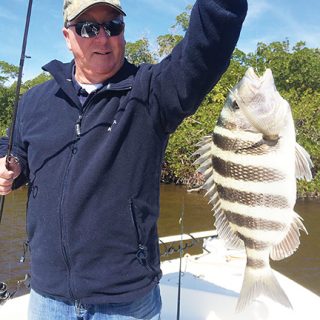By Capt. Terry Fisher

However, my advice to all ‘recreational’ fishermen and ladies, is to fish the ‘top half of an incoming or the top half of the outgoing’ tide, as water movement generates much needed oxygen and motivates bait and feeding activities, regardless of tide levels.
2) FISH FOR SPECIES THAT OFFER THE BETTER SEASONAL OPPORTUNITIES: My December article in Coastal Angler Magazine titled, ‘INSHORE FISHING SW FLORIDA WATERS IS GOOD YEAR AROUND’, provided suggestions on which species to target on a quarterly basis throughout the year. This month’s article offers more specifics for January fishing from Ft. Myers Beach to Charlotte Harbor.
January is a good month to target Sheepshead. They begin migrating inshore from the depths of the Gulf of Mexico, to spawn. Their appetite will be ferocious and should make for a great day of fishing. They take up residency around piles, in rock structure and mangroves. Large sheepshead prefer to school in locations with stronger currents that carry bait ‘to and fro’, while providing higher oxygen levels (a deadly combination)! When the smaller fish bite, the larger ones will be scarce. At some point however, the larger sheepshead will take over, offering an hour or more of non-stop excitement. I suggest light tackle. For example; a 3000 series spin reel, loaded with 10lb to 15lb line test mounted on a matching 7’ fast action rod, will do the job. Use a 30lb. Fluorocarbon leader with a #5 or #6 pinch weight a few inches above a size 1 bait hook. Baits of choice are small shrimp and fiddler crabs. Rumor has it that sheepshead are hard to catch. NOT TRUE! A mangrove snapper or pinfish will tap the bait, while a sheepshead will offer a mild but distinguished ‘tug’ or slight ‘pull’. When you feel this, set the hook!
(Note: if fishing for mangrove snapper, use a circle hook, it is the law)
Big seatrout, big Spanish mackerel, pompano and anything else that swims will be on and around the flats. I target these species in around 4ft. to 7ft. of water with shrimp on a weighted jig head, suspended under a cork just above the turtle grass (olive green colored water will denote that grass exits and the location is likely to produce fish). Most of the bounty will consist of seatrout, a few Spanish mackerel, and the occasional pompano. Everything that swims will consider this presentation including Jack Crevalle and ladyfish. Effective artificial presentations include; top- water, spoons, twitch, swim and crank baits. Silly Willy jigs tipped with a small piece of shrimp works well for pompano.
However, when targeting Spanish mackerel, I will fish open and deeper water, including just off the beaches of the outer islands and Charlotte Harbor. Look for diving birds. Fish depths from 6ft. to 9ft. Use a cork with a leader length just above the bed of the estuary. I use a jig head with live shrimp. Good artificial presentations are effective as well. I prefer to use Johnson Spoons with swivels and Gotcha Lures on heavier 40lb. monofilament; otherwise one will lose a lot of lures.
Snook are here year around, but are harder targets without the proper vessels and equipment. Trolling motors are virtually a must for fishing areas where these fish are likely to hold. Pilchards, pinfish and big shrimp are the best live baits. Artificial presentations, such as top-water, soft plastics, twitch and swim baits work. Trolling small-lipped swim baits in canals will catch snook and Jack Crevalle. Those with the proper boat and equipment; fish under docks, along side of islands with a lot of water movement, points of islands, the passes and around mangroves on outgoing tides. Finding redfish in January can be difficult, but occasionally are found.
Consider yourself good or lucky if you find them.
It is my hope that this article will give those wanting to fish this January sufficient information to make the most of it.
This is Captain Terry Fisher of Fish Face Charters wishing everyone a ‘Fish of a Lifetime’! Feel free to contact me via email at fishfacecharters@yahoo.com with any questions or charter requests. You can also call me direct at 239-357-6829 to book your charter or for immediate assistance. Check out my website at www. fishfacecharters.com for more fishing tips and reports. I am also available as ‘Captain for Hire’ (by the hour) on your vessel for navigation/safety instructions, fishing locations and techniques.
